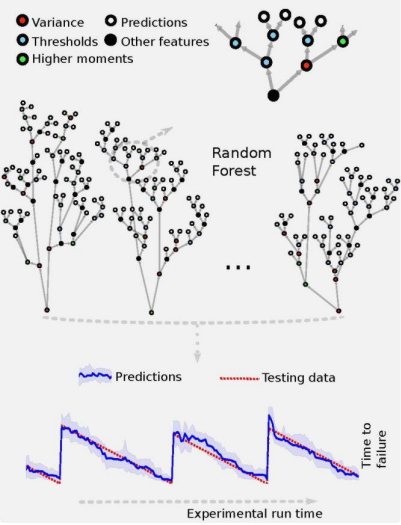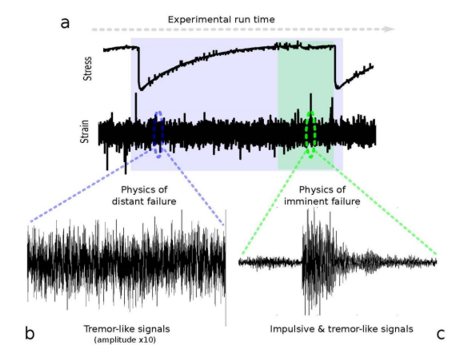| Earthquake Prediction Using Machine Learning |
| Written by Sue Gee | |||
| Tuesday, 05 September 2017 | |||
|
Machine Learning is good it identifying signals that human observers might not notice. Researchers at Los Alamos have used it with a laboratory-created earthquake simulation to predict the time remaining before a fault fails. We have already seen machine learning being applied in a range of scenarios so you might think that the news that machine-learning earthquake prediction in lab shows promise isn't out of the ordinary. If you are a geologist, however, this is really exciting. To quote the first sentence of an early draft of the report that has now been accepted for Geophysical Research Letters: Forecasting fault failure is a fundamental but elusive goal in earthquake science. The research comes from the Los Alamos National Laboratory and its lead investigator Paul Johnson explains: "The novelty of our work is the use of machine learning to discover and understand new physics of failure, through examination of the recorded auditory signal from the experimental setup. I think the future of earthquake physics will rely heavily on machine learning to process massive amounts of raw seismic data. Our work represents an important step in this direction." The abstract of the paper co-authored by Johnson with Bertrand Rouet-Leduc, Claudia Hulbert, Nicholas Lubbers, Kipton Barros and Colin Humphreys concentrates on the geophysics: We apply machine learning to data sets from shear laboratory experiments, with the goal of identifying hidden signals that precede earthquakes. Here we show that by listening to the acoustic signal emitted by a laboratory fault, machine learning can predict the time remaining before it fails with great accuracy. These predictions are based solely on the instantaneous physical characteristics of the acoustical signal, and do not make use of its history. Surprisingly, machine learning identifies a signal emitted from the fault zone previously thought to be low-amplitude noise that enables failure forecasting throughout the laboratory quake cycle. We infer that this signal originates from continuous grain motions of the fault gouge as the fault blocks displace. We posit that applying this approach to continuous seismic data may lead to significant advances in identifying currently unknown signals, in providing new insights into fault physics, and in placing bounds on fault failure times. The machine learning technique used to predict the time remaining before failure in the earthquake simulation was the Random Forest approach which predicts the time remaining before the next failure by averaging the predictions of 1000 decision trees for each time window.
As illustrated in the above figure, each tree makes its prediction (white leaf node), following a series of decisions (colored nodes) based on features of the acoustic signal during the current window). The RF prediction (blue line) on data it has never seen (testing data) with 90% confidence intervals (blue shaded region). The predictions agree remarkably well with the actual remaining times before failure (red curve). A particular success of this research was that it identified new signals, previously thought to be low-amplitude noise, that provide forecasting information throughout the earthquake cycle. As the paper explains: Surprisingly, the RF model accurately predicts failure not only when failure is imminent, but throughout the entire labquake cycle, demonstrating that the system continuously progresses towards failure throughout the stress cycle. This is unexpected, as impulsive precursors are only observed while the system is in a critical stress state.
Whether ML approaches applied to continuous seismic or other geophysical data succeed in providing information on timing of earthquakes (not to mention earthquake magnitude), this approach may reveal unidentified signals associated with undiscovered fault physics. Furthermore, this method may be useful for failure prediction in a broad spectrum of industrial and natural materials. Technology is at a confluence of dramatic advances in instrumentation, machine learning, the ability to handle massive data sets and faster computers. Thus, the stage has been set for potentially marked advances in earthquake science. As far as computer scientists are concerned this seems to be an opportunity for validation of the RF machine learning technique.
More InformationMachine-learning earthquake prediction in lab shows promise Related ArticlesMachine Learning For Flower Recognition IBM Inventors Patent Earthquake Detection System Google's Post-Earthquake Mapping and Imagery Building A Digital Twin With Predix
To be informed about new articles on I Programmer, sign up for our weekly newsletter, subscribe to the RSS feed and follow us on Twitter, Facebook or Linkedin.
Comments
or email your comment to: comments@i-programmer.info |
|||
| Last Updated ( Tuesday, 05 September 2017 ) |




